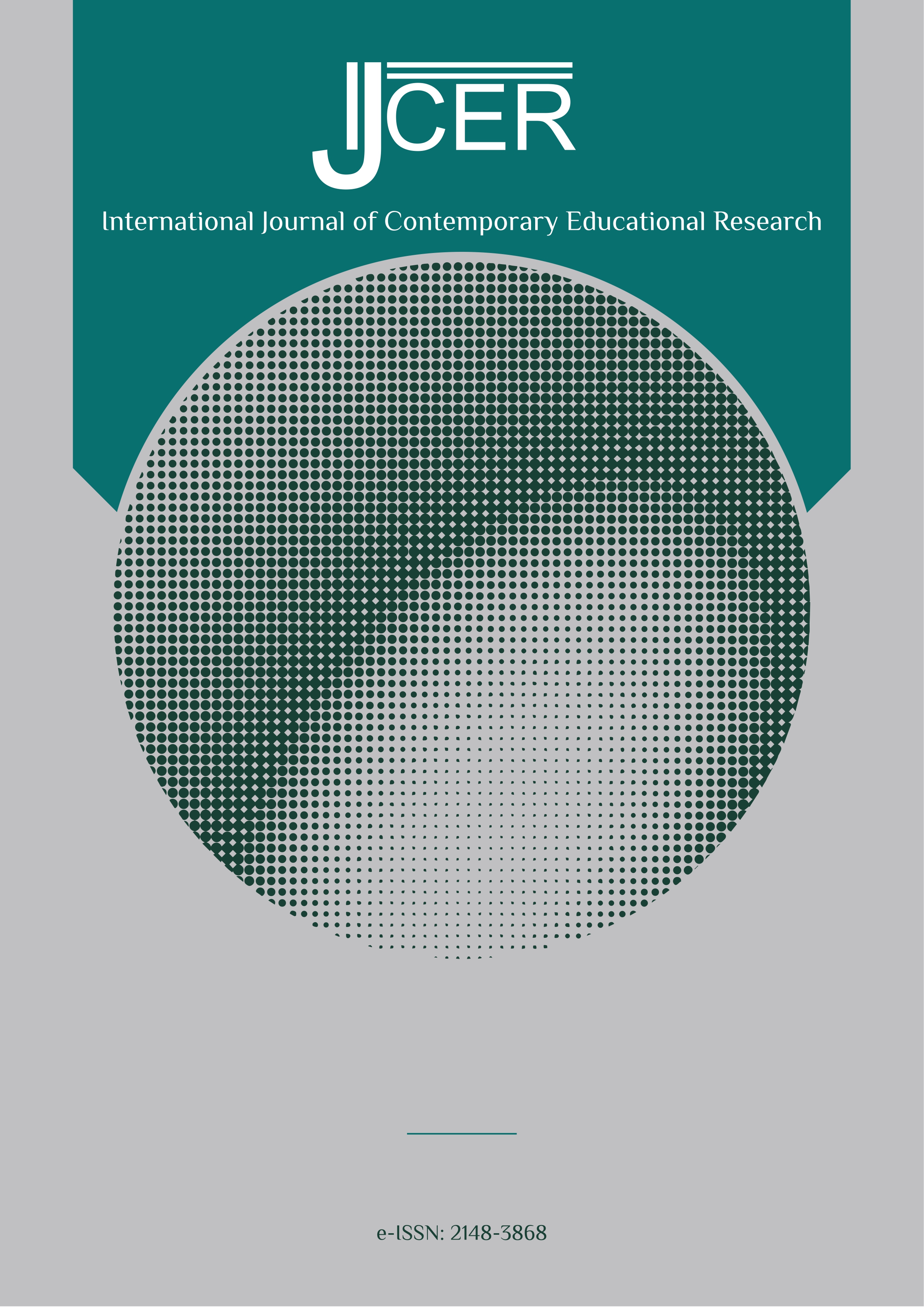The Relationship Between Motivation to Teach, School Climate, and Attitude Toward Teaching Profession
DOI:
https://doi.org/10.52380/ijcer.2025.12.1.800Keywords:
Motivation to teach , School climate, Attitudes towards teaching professionAbstract
This study examines the relationships between pre-service teachers' motivation to teach, their perceptions of school climate, and their attitudes toward the teaching profession. Data were collected from 377 pre-service teachers studying at a state university in Turkey. Structural equation modeling (SEM) revealed that motivation to teach significantly and positively predicted attitudes towards teaching profession both directly and indirectly through school climate. While motivation to teach also significantly predicted school climate, school climate had a smaller but significant effect on professional attitudes. The model explained 69% of the variance in professional attitudes and 47% of the variance in school climate. These findings emphasize the importance of strengthening intrinsic motivation and creating supportive educational environments to promote positive professional attitudes in teacher education.
References
Al-Asme, M. B. K. (2022). Teachers' attitudes towards the teaching profession among government school teachers in the Sultanate of Oman. Journal of the College of Education, Ain Shams University, 46(3), 63-89.
Ali, A. K., & Saleh, M. (2021). Contribution of the principal's transformational leadership and school climate on teacher performance through work motivation. Journal of K6 Education and Management, 4(1), 81-90.
Andronache, D., Bocoş, M., Bocoş, V., & Macri, C. (2014). Attitude towards teaching profession. Procedia-Social and Behavioral Sciences, 142, 628-632. https://doi.org/10.11594/jk6em.04.01.08
Ayık, A., & Ataş, Ö. (2014). Öğretmen adaylarının öğretmenlik mesleğine yönelik tutumları ile öğretme motivasyonları arasındaki ilişki. Eğitim Bilimleri Araştırmaları Dergisi, 4(1), 25-43. : http://dx.doi.org/10.12973/jesr.2014.41.2
Bas, G. (2022). Effect of student teachers’ teaching beliefs and attitudes towards teaching on motivation to teach: mediating role of self-efficacy. Journal of Education for Teaching, 48(3), 348-363. https://doi.org/10.1080/02607476.2021.2006043
Bowen, N. K., & Guo, S. (2011). Structural equation modeling. Oxford University Press.
Cardina, C. E., & Fegley, J. M. (2016). Attitudes Towards teaching and perceptions of school climate among health education teachers in the United States, 2011-2012. Journal of Health Education Teaching, 7(1), 1-14.
Cohen, J., & Geier, V.K. (2010). School Climate Research Summary: January 2010. 〈www. schoolclimate.org/climate/research.php〉
Cohen, J., McCabe, E. M., Michelli, N. M., & Pickeral, T. (2009). School climate: Research, policy, practice, and teacher education. Teachers College Record, 111(1), 180–213. https://doi.org/10.1177/016146810911100108
Davison, A. C., & Hinkley, D. V. (1997). Bootstrap methods and their application (No. 1). Cambridge university press.
Davulcu, Ö., Kuluma , H. & Kaçmaz, S. (2021). Examining the relationship between the school climate and motivation of teachers who work in primary and secondary schools. Global Journal of Guidance and Counseling in Schools: Current Perspectives, 11(1), 01-14. https://doi.org/10.18844/gjgc.v11i1.5601
Eagly, A. H., & Chaiken, S. (1993). The psychology of attitudes. Harcourt brace Jovanovich college publishers.
Efron, B., & Tibshirani, R. J. (1994). An introduction to the bootstrap. Chapman and Hall/CRC.
Fang, J., & Qi, Z. (2023). The influence of school climate on teachers’ job satisfaction: The mediating role of teachers’ self-efficacy. Plos one, 18(10), e0287555. https://doi.org/10.1371/journal.pone.0287555
Fornell, C., & Larcker, D. F. (1981). Evaluating structural equation models with unobservable variables and measurement error. Journal of marketing research, 18(1), 39-50. https://doi.org/10.1177/002224378101800104
Garrett, P. (2010). Attitudes to language. Cambridge University Press.
Güneş, A. M. (2019). Öğretmen adaylarının öğretmenlik mesleğine yönelik tutumlarıyla okul iklimi arasındaki ilişki. Ahi Evran Üniversitesi Kırşehir Eğitim Fakültesi Dergisi, 20(3), 1595-1632. https://doi.org/10.29299/kefad.2019.20.03.017
Hair Jr, J. F., Hult, G. T. M., Ringle, C. M., Sarstedt, M., Danks, N. P., & Ray, S. (2021). Partial least squares structural equation modeling (PLS-SEM) using R: A workbook (p. 197). Springer Nature. https://doi.org/10.1007/978-3-030-80519-7
Han, J., & Yin, H. (2016). Teacher motivation: Definition, research development and implications for teachers. Cogent education, 3(1), 1217819. https://doi.org/10.1080/2331186X.2016.1217819
Hu, L. T., & Bentler, P. M. (1999). Cutoff criteria for fit indexes in covariance structure analysis: Conventional criteria versus new alternatives. Structural equation modeling: a multidisciplinary journal, 6(1), 1-55. https://doi.org/10.1080/10705519909540118
Kahramanoğlu, R., Yokuş, E., Cücük, E., Vural, S., & Şiraz, F. (2018). Öğretmenlik mesleğine yönelik tutum ölçeği (ÖMYTÖ) geçerlik ve güvenirlik çalışması. Turkish Studies, 13, 11. http://dx.doi.org/10.7827/TurkishStudies.13561
Kanadlı, S. (2017). Prospective teachers' professional self-efficacy beliefs in terms of their perceived autonomy support and attitudes towards the teaching profession: A mixed methods study. Kuram ve Uygulamada Egitim Bilimleri, 17(5), 1847-1871. DOI 10.12738/estp.2017.5.0597
Kauffman, D. F., Soylu, M. Y., & Duke, B. (2011). Validation of the motivation to teach scale. Hacettepe Üniversitesi Eğitim Fakültesi Dergisi, 40(40), 279-290.
Kline, R. B. (2023). Principles and practice of structural equation modeling. Guilford publications.
Kock, N. (2017). Common method bias: a full collinearity assessment method for PLS-SEM. Partial least squares path modeling: Basic concepts, methodological issues and applications, 245-257. https://doi.org/10.1007/978-3-319-64069-3_11
Kontas, H. (2016). The Effect of an Education-Themed Movie on the Academic Motivation of Teacher Candidates and Their Attitude Towards Teaching Profession. Journal of Education and training studies, 4(6), 93-103. http://dx.doi.org/10.11114/jets.v4i6.1483
Kula, S. S. (2022). The predictive relationship between pre-service teachers’ self-efficacy belief, attitudes towards teaching profession and teaching motivation. International Journal of Contemporary Educational Research, 9(4), 705-718. https://doi.org/10.33200/ijcer.1068573
Maxwell, A. R. (2016). The composition and characteristics of teacher self-efficacy for inclusive practice. University of Exeter (United Kingdom).
McCarthy, C. J., R. G. Lambert, S. Lineback, P. Fitchett, and P. G. Baddouh. 2016. “Assessing Teacher Appraisals and Stressin the Classroom: Review of the Classroom Appraisal of Resources and Demands.” Educational Psychology Review 28:577–603. https://doi.org/10.1007/s10648-015-9322-6.
Nilsen, T., Gustaffsson, J.-E., Bl¨omeke, S., 2016. Conceptual framework and methodology of this report. In: Nilsen, T., Gustafsson, J.-E. (Eds.), Teacher quality, instructional quality and student outcomes. Springer Open. DOI 10.1007/978-3-319-41252-8_1
Nunnally, J. C., & Bernstein, I. H. (1994). Psychometric theory. New York: McGraw-Hill.
Philipp, R. A. (2007). Mathematics teachers’ beliefs and affect. Second handbook of research on mathematics teaching and learning, 1, 257-315.
Pinkas, G. (2022). The Relationship between Perception of School Climate and Teacher Motivation. DHS-Društvene i humanističke studije: časopis Filozofskog fakulteta u Tuzli, 20(20), 209-228. https://doi.org/10.51558/2490-3647.2022.7.3.209
Pişmek, N., Pişmek, Ü. & Akyüz Çömez, S. (2023). Okul İklimi ve Öğretmen Motivasyonu Arasındaki İlişkinin İncelenmesi, International Social Mentality and Researcher Thinkers Journal, (Issn:2630-631X) 9(75): 4429-4457. DOI: http://dx.doi.org/10.29228/sm ryj.70757
Podsakoff, P. M., MacKenzie, S. B., Lee, J. Y., & Podsakoff, N. P. (2003). Common method biases in behavioral research: a critical review of the literature and recommended remedies. Journal of applied psychology, 88(5), 879. https://doi.org/10.1037/0021-9010.88.5.879
Rahman, A. K., & Ashraf, P. (2020). A Study on The influence of school organizational climate and attitude of teachers. Our Heritage, 68(1), 3709-3712.
Richardson, P. W., & Watt, H. M. (2018). Teacher professional identity and career motivation: A lifespan perspective. Research on teacher identity: Mapping challenges and innovations, 37-48. https://doi.org/10.1007/978-3-319-93836-3_4
Robbins, S. P., & Judge, T. (2013). Comportamiento organizacional: edición 15. Pearson educación.
Sari, H., & Yetkiner, A. (2020). Relationships between Job Satisfaction, Motivation and Life Satisfaction in the Teachers: A Structural Equation Modeling Study. International Journal of Progressive Education, 16(3). https://doi.org/10.29329/ijpe.2020.248.16
Sun, C. (2017). Attitudes of chinese preschool teachers towards inclusion of students with special needs in relation to teacher self-efficacy and school climate (Doctoral dissertation, University of the Pacific).
Terzi, A. R., & BAÜ, N. E. F. (2015). Developing a school climate scale for university students. Journal of Research in Education and Teaching, 4(4), 111-117.
Thapa, A., Cohen, J., Guffey, S., & Higgins-D’Alessandro, A. (2013). A review of school climate research. Review of educational research, 83(3), 357-385. https://doi.org/10.3102/0034654313483907
Toropova, A., Myrberg, E., & Johansson, S. (2021). Teacher job satisfaction: the importance of school working conditions and teacher characteristics. Educational review, 73(1), 71-97. https://doi.org/10.1080/00131911.2019.1705247
Uçgun, D. (2013). Türkçe öğretmenlerinin öğrencileri motive etme düzeyleri ile ilköğretim 6. sınıf öğrencilerinin Türkçe dersine yönelik tutumları arasındaki ilişki. Mersin Üniversitesi Eğitim Fakültesi Dergisi, 9(2), 449-460. https://doi.org/10.17860/efd.56606
Ullman, J. B., & Bentler, P. M. (2012). Structural equation modeling. Handbook of psychology, second edition, 2.
Üstüner, M. (2006). Öğretmenlik mesleğine yönelik tutum ölçeğinin geçerlik ve güvenirlik çalışması. Kuram ve Uygulamada Eğitim Yönetimi, 45(45), 109-127.
Vermote, B., Vansteenkiste, M., Soenens, B., & Beyers, W. (2023). Which teachers feel good and adopt a motivating teaching style? The role of teaching identity and motivation to teach. Studies in Higher Education, 49(11), 2235–2261. https://doi.org/10.1080/03075079.2023.2296565
Wang, M. T., & Degol, J. L. (2016). School climate: A review of the construct, measurement, and impact on student outcomes. Educational psychology review, 28(2), 315-352. https://doi.org/10.1007/s10648-015-9319-1
Weisel, A., & Dror, O. (2006). School climate, sense of efficacy and Israeli teachers’ attitudes toward inclusion of students with special needs. Education, Citizenship and Social Justice, 1(2), 157-174. https://doi.org/10.1177/1746197906064677
Yamina, Q. (2021). Students' attitudes toward the teaching profession and its relationship to university students' motivation for achievement. An Unpublished Master’s Thesis, Ahmed Draya University, Adrar, Department of Social Sciences, Algeria.
Yıldız, B. B., Gunay, G., & Özbilen, F. M. (2021). Evaluation of Teachers' Motivation and Curriculum Autonomy Levels. Educational Policy Analysis and Strategic Research, 16(2), 330-353. https://doi.org/10.29329/epasr.2020.345.15
Zeidan, S. S. (2023). Teacher Motivation, School Climate Student Behavior in Louisiana (Doctoral dissertation, Grand Canyon University).
Zhao, K., Chen, N., Liu, G., Lun, Z., & Wang, X. (2023). School climate and left-behind children’s achievement motivation: The mediating role of learning adaptability and the moderating role of teacher support. Frontiers in Psychology, 14, 1040214. https://doi.org/10.3389/fpsyg.2023.1040214
Downloads
Published
How to Cite
Issue
Section
License
Copyright (c) 2025 Emirhan Yetiş

This work is licensed under a Creative Commons Attribution-NonCommercial 4.0 International License.




